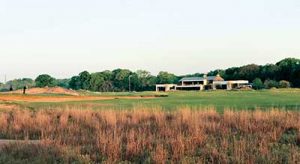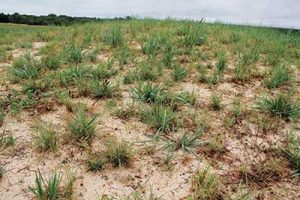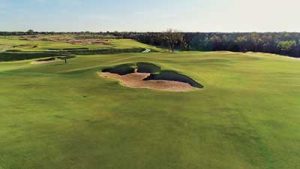Living off the land(fill): A look at Trinity Forest GC’s origins

Trinity Forest Golf Club’s Hole No. 2, with the clubhouse in the background.
Golf courses developed atop former landfills, once a novelty, today are fairly commonplace, though the construction and subsequent maintenance of these courses is as varied as the trash heaps on which they sit.
Public exposure to this genre may never be higher than later this month, when Trinity Forest Golf Club in Dallas plays host to the PGA Tour’s 50th Anniversary AT&T Byron Nelson Classic May 14-20. But it’s unlikely that television commentators (or the golf writers who cover Tour events) will see fit to detail just how anomalous this project remains.
For starters, Trinity Forest GC is a private club, whereas most landfill courses are owned and managed by municipalities still responsible for the decommissioned landfills themselves. Because of this, the development consortium here brimmed with stakeholders: the city of Dallas, club investors, course designers Coore & Crenshaw, construction firm Landscapes Unlimited, owner’s rep firm Oncore, the Audubon Society of Dallas (the site essentially is surrounded by environmentally protected land), and Kasey Kauff, the course superintendent retained well before the first of 750,000 cubic yards of fill was ever delivered to the site, some 8 miles south of downtown Dallas.
“We were brought in early, before everything was finalized, so we could help out with budgeting, projections, logistics and the navigation of regulations — to help them get to the starting line,” says Ty Arndt, the project manager for Landscapes Unlimited at Trinity Forest. “This is fairly typical, but it still stands out for us because every feature out there today was built out of fill. There were no cuts here, zero cuts. We had to stay away from the landfill cap at all costs. If the architect wanted a low spot in the fairway, we had to build up the surrounds to achieve that.
“Bill [Coore] and Ben [Crenshaw] loved this site because the landfill had been improperly constructed. It suffered a whole bunch of settling over the years that just happened to produce lots of very pockmarked, linksy surfaces. They loved that look. But when the city came back in to remediate one last time before we got busy, a lot of that got changed and plated over with flat clay. So, part of our challenge was to use all that fill to replicate the look of those settled areas that hadn’t been plated over.”
Good news and bad news
All the fill was harvested from a borrow pit located just off site on city-owned land, but it was anything but uniform. According to Jack Morgan, program manager for Landscapes Unlimited at Trinity Forest, there were three main types of soil: a sandy loam, a clay-based amalgam and a heavy gravel mixture. Instead of blending the loam and clay to create a single medium (and discarding the gravel), Landscapes and Kauff elected to surgically excavate and scrutinize every truckload, identify it, then spread it accordingly: sandy loam on greens, fairways and tees; clay in the immediate outlying, contoured areas; and the gravel in the native areas called for in Coore & Crenshaw’s design.
“Every ounce of fill was imported from that borrow pit, and whenever the excavators ran across a particular sort of material, we’d direct them to a different part of the golf course,” Morgan says. “It disrupted our sequencing on this job, but eventually we got into a groove and things went smoothly.”

Setting aside its origins as two separate landfills, Trinity Forest Golf Club now has a links-style design that took extensive work to construct.
That’s the bad news: 750,000 cubic yards is a lot of fill. Assessing each truckload was time consuming. The good news? A course superintendent seldom has a good idea of what growing medium he’s dealing with where. At Trinity Forest, Kauff knows exactly — and he appreciates how often a superintendent is extended this luxury.
“Probably never! But here’s the reality,” Kauff reasons. “Let’s say I had a piece of land and I vigorously soil sampled that piece of land prior to construction. When you start shaping, cutting and filling, you change the profile. You’re taking some good soil on top and pushing it over there; you’re cutting, filling and changing it. You’re never going to have a beautiful mat of consistent soil across the whole property. Our situation was a real luxury.”
Even so, once the irrigation was laid in, Kauff and his crew did themselves one better. They went to every sprinkler head, mapped and labeled them via GPS, then took a soil sample and sent it for testing.
“I can look at this map and see exactly what is where (as far as) nutrients and soil characteristics. Even with all the work we did up front (directing specific soil types to specific places), we have very different soils across the property, across a single hole. I remember the first load of fill they brought for greens. I said, ‘That’s not going to work.’ We pushed it to the side and now it’s a mound next to the 5th green. It was a real interesting process — one I’ll never experience again.
“Part of (No.) 11 has some spots with very rocky soil. It was put there — it shouldn’t have been, but it was. Knowing that, I can correlate it to our programs, what its different needs are. Even now when we fertilize, we may go across an area like that twice. Everyone knows where those spots are. Because we mapped it, the staff here will always know.”

The native areas at Trinity Forest consist of blackland prairie grasses planted to reinstitute the endangered vegetation.
Complicated construction
Trinity Forest sits on two separate former landfills. The clubhouse and course rest comfortably on some 200 acres just south of Highway 12. On the north side sits the high-end practice facility (home to the Southern Methodist University golf team), a short course and a First Tee facility. Taken together, it’s a beautiful highland tableau rising from the preserves flanking the Trinity River floodplain.
That said, what golf fans will see on television later this month belies the mess Arndt and his crews discovered during construction.
“There was no toxic stuff out there, but it was a lot of trash,” Arndt says. “You don’t get that on a modern landfill that was better constructed, newer and properly engineered. This one was so old and poorly constructed, we never knew what we’d run into. In those cases, we had to separate trash, contain it, store it in a separate container and bring it to another landfill.
“This site sits high, but it was pretty flat. With the restrictions on cuts, you can imagine a low area in the middle of the parcel — it’s got to drain somewhere. So, we did get some variances to install water-tight pipe in the trash layer to get that done. There are special regulations related to that, of course, and we couldn’t alter the cap in any way.”
According to Morgan, Landscapes instituted another process, called cap control, in which crews had to certify each day that they were not cutting, changing or in any way lowering the elevation of the landfill cap.
“We had one or two full-time folks roving around with GPS receivers on their carts checking grades every day, all day long. These were very tight tolerances — to the inch,” Morgan says. “We had to really get into a whole different realm on this job. We normally have a very formal and rigid program, but methane monitors for the gas release? We had to check against methane all the time. We had an evacuation protocol. We had to take on the safety program that a landfill operator would. I’m very proud we had zero incidents.”
Overlaying the entirety of Trinity Forest is Trinity zoysia — formerly known as L1F zoysiagrass. It’s the first course to have been sprigged wall to wall with it. Supplied by Bladerunner and All Seasons farms, the zoysia required nine months, or two growing seasons, to fully mature. That’s the only downside Kauff could relate.
“We had the luxury of that long grow-in period, but if you plant what is right for your area, it’s amazing what you can do with it and how few inputs you actually need to be successful,” he says. “It’s pretty amazing but it makes sense. If you plant bentgrass here in Texas, then you’re going to need more inputs to be successful.”

The Trinity Forest Golf Club team, (left to right) Sarah Jackson, assistant; Cory Colgrove, equipment manager; James Morgan, lead assistant; Chad Kuzawa, golf course superintendent; Kasey Kauff, director of grounds; Adam Deiwert, north side superintendent; Ben Zawacki, assistant; and Grant Sherwood, assistant.
Endangered ecosystem
This was the same strategy Kauff and Landscapes deployed in tending to the massive outlying areas at Trinity Forest GC. The club isn’t just bounded (on three sides) by the Trinity River Audubon Center, McCommas Bluff and Joppa Preserve. Prior to the 20th century development of North Texas (urban and agricultural), this entire area was part of an unbroken ecosystem known as blackland prairie, which stretched south into Mexico.
“This is one of the most endangered ecosystems we have,” Arndt says, “so the developers and Kasey worked with the local Audubon to reinstitute blackland prairie vegetation — and it’s thrived. I don’t think I’ve ever worked on a project with such productive collaboration between so many parties, on so many fronts. Kasey gets a lot of credit for that.”
These natural areas received the least desirable soils from the borrow pit, but it hardly mattered.

Trinity Forest GC’s No. 3 and No. 11 double green is 35,000 square feet.
“We identified 30 to 40 native species, irrigated them to germinate, then turned the water off and let nature do it,” Kauff says. “We all came from more parkland-style golf courses (Kauff arrived in Dallas from The CC of Orlando), so we had to have everyone buy into the strategy here: no chemicals, just rainwater. If we get noxious weeds — like Johnson grass — we shovel it out. Otherwise, it is what it is. In low areas with more water, you get different species than the high areas. If it rains, it turns green. But these plants are used to no rain for three to four months. They just turn brown. It’s a pretty awesome thing, to see it respond to the elements. Of course, I wouldn’t do this in Alabama…”
How will these blackland prairie areas cope with daily galleries of 25,000 people come tournament week?
“I don’t know. In the course of history these areas were beaten down by herds of bison. Can it handle 100,000 people? That is an unknown. We’re prepared for it to be successful and we’re prepared to go back in and seed. We’ll be mowing some corridors but honestly, I don’t know how that will work,” Kauff says. “People come, they leave, we clean it up.”
If only every former landfill could be so lucky.
Photos: Kasey Kauff (1, 2, 4); Seth Jones (3); Andy Johnson (5)










